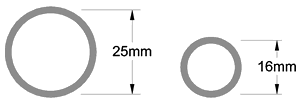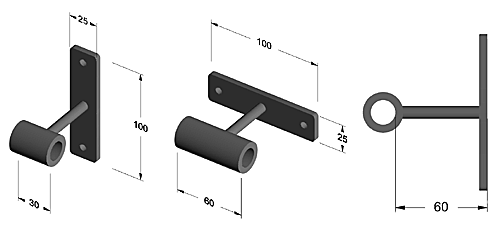
Measuring & Fitting Curtain Poles
|
Measuring
& fitting •
|
|
Measuring for standard windows
- Measure the full width of the window, including frame, to give initial pole size. Take all measurements at height at which pole is to be fitted.
- Add at least 10cms extra pole for each side to allow for brackets and for curtains to be drawn back beyond window frame (more for larger curtains).
- It's always better to order more pole than you might need. Any excess can easily be trimmed with a hacksaw.
- If space is tight, remember to consider the length of the finials beyond total pole length.

- Overall width of window, including frame = 200cms
- Add minimum 10cms x 2 for overhang and brackets.
- Minimum length of pole required = 220cms
A few considerations when measuring...
- Check for any obstructions, such as beams, that might make it difficult to fit or site the brackets
- If walls are particularly uneven you may need to fit wooden battens to fix brackets onto
- If the wall has an unstable or weak surface, e.g. plasterboard or lath and plaster walls, wooden battens again will give a stronger fixing surface
- Don't forget to check for concealed pipes and wiring in the wall
Note: We do not currently offer a measuring or fitting service. If you feel unable to measure for, or fit your curtain poles, we recommend that you find a suitably qualified tradesperson.
Bay windows (back to top)
Curtain pole and brackets (back to top)
| Curtain pole is available in 16mm and 25mm diameters. The 16mm poles are solid bar whereas, for weight considerations, the 25mm pole is hollow tube. Our packs are available with 4 lengths of pole, 1m, 1.5m, 2m and 3m. If you prefer we will cut the pole to the specific length you require. When ordering simply choose a pack with the nearest pole size larger than the length you need and then specify the required length in the checkout form. |
 |
|
Standard brackets for straight pole - Centre bracket has a longer round collar than the standard sleeve bracket. The back fixing plate runs horizontally to allow the bracket to fit above a window frame. Also used to join two lengths of pole. |
 |
|
Bay pole brackets - similar size to standard brackets but are length adjustable to make bay pole fitting easier. The back plates can be rotated to run horizontally or vertically. Pass-over brackets are permanently welded to underside of pole (bracket shown unattached in diagram). |
 |
| Pass-over bracket - shown from various angles with pass-over ring on pole |  |
Please note: The sizes we give for brackets and finials are approximate due to the nature of the materials and the handmade manufacture. If you need more accurate sizes for specific fittings please let us know. Supplied fixings may not be suitable for all situations, more specialised fixings may be required in plasterboard or other weak surfaces.
DIY Safety (back to top)
Although installing our curtain poles is usually straightforward, fitting difficulty can vary depending on the fixing surface and the ease of access to it. If you are at all unsure about your ability to undertake the work, we would recommend that you consult a professional tradesperson.
Safety is also an issue when DIY jobs are attempted by people with little day to day experience of such work. For further information about DIY safety, leaflets are available as downloadable pdf files from the DTI website. Click here for further information.

Copyright © The Northdowns Ironcraft Co. 2001-2015, all rights reserved E&OE. Terms & Conditions - Privacy